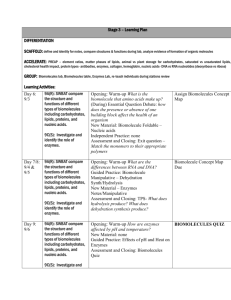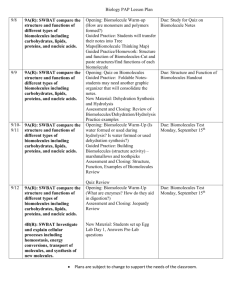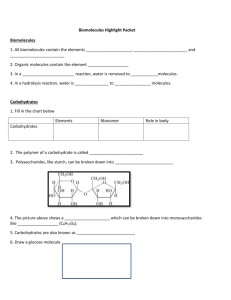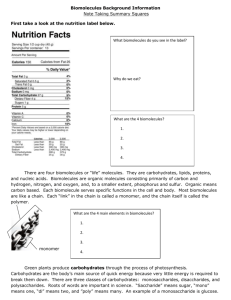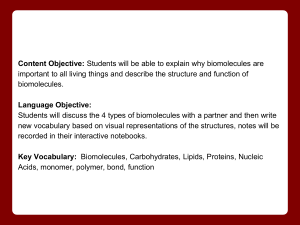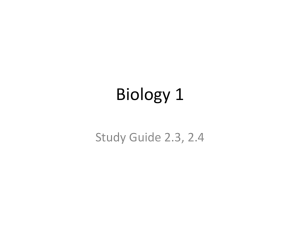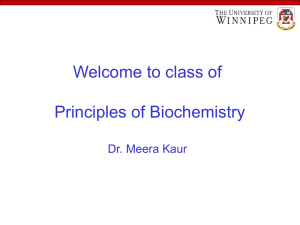CAMP Biology PreAP Unit 1: Biomolecules (9A,9C) 8/26 – 9/12
advertisement
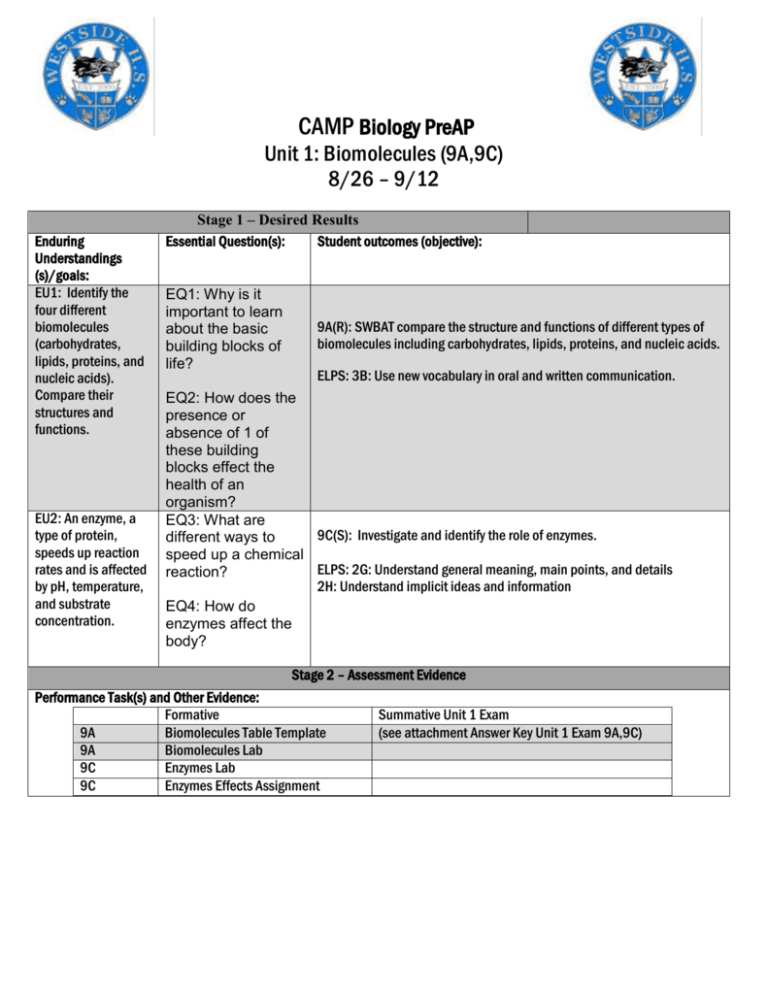
CAMP Biology PreAP Unit 1: Biomolecules (9A,9C) 8/26 – 9/12 Enduring Understandings (s)/goals: EU1: Identify the four different biomolecules (carbohydrates, lipids, proteins, and nucleic acids). Compare their structures and functions. EU2: An enzyme, a type of protein, speeds up reaction rates and is affected by pH, temperature, and substrate concentration. Stage 1 – Desired Results Essential Question(s): Student outcomes (objective): EQ1: Why is it important to learn about the basic building blocks of life? 9A(R): SWBAT compare the structure and functions of different types of biomolecules including carbohydrates, lipids, proteins, and nucleic acids. ELPS: 3B: Use new vocabulary in oral and written communication. EQ2: How does the presence or absence of 1 of these building blocks effect the health of an organism? EQ3: What are 9C(S): Investigate and identify the role of enzymes. different ways to speed up a chemical ELPS: 2G: Understand general meaning, main points, and details reaction? 2H: Understand implicit ideas and information EQ4: How do enzymes affect the body? Stage 2 – Assessment Evidence Performance Task(s) and Other Evidence: Formative 9A Biomolecules Table Template 9A Biomolecules Lab 9C Enzymes Lab 9C Enzymes Effects Assignment Summative Unit 1 Exam (see attachment Answer Key Unit 1 Exam 9A,9C) Stage 3 – Learning Plan DIFFERENTIATION SCAFFOLD: define and identity for notes, compare structures & functions during lab, analyze formation of organic molecules ACCELERATE: PREAP – element ratios, matter phases of lipids, animal vs plant storage for carbohydrates, saturated vs unsaturated lipids, cholesterol health impact, protein types- antibodies, enzymes, collagen, hemoglobin, nucleic acids- DNA vs RNA nucleotides (deoxyribose vs ribose) GROUP: Biomolecules lab, Biomolecules table, Enzymes Lab, re-teach individuals during stations review Learning Activities: Date Student Outcomes (Objectives) Get to know teacher & Day 1: students 8/26 Student Assignments Read pages #36, 51 (All of Carbon Bonding) & #53-60 in textbook. Answer Section Reviews 9C(S): Investigate and identify the role of enzymes. Opening: Who are you? New Material: Classroom Rules Guided Practice: Lab Safety Assessment and Closing: Get your textbook Opening: New Material: What is Biology? Guided Practice: Review rules Assessment and Closing: Buy a lab notebook! Opening: What’s in Your Food? New Material: Biomolecules Guided Practice: Pre-Assessment, Biomolecules 4 min video clip & questions, Biomolecules Stations & Foldable Assessment and Closing: TPS- function of each biomolecule Opening: Warm-up What are the 4 biomolecules? Name 1 example for each biomolecule. New Material: Monomers & Polymers & Hydrolysis/Dehydration Synthesis Guided Practice: Biomolecules Frayer Models, Notes on H&DS, Identifying Hydrolysis/Dehydration Synthesis Manipulatives Assessment and Closing: exit question- list elements found in each biomolecule 9A(R): SWBAT compare the structure and functions of different types of biomolecules including carbohydrates, lipids, proteins, and Opening: Warm-up New Material: none Guided Practice: Pre-Assessment for Biology & Biomolecules Concept Map Assessment and Closing: Turn in to be graded Due: Biomolecules Concept Map Read pages __________ Day 2: 8/27 Syllabus, supplies Day 3/4: 8/28 & 8/29 9A(R): SWBAT compare the structure and functions of different types of biomolecules including carbohydrates, lipids, proteins, and nucleic acids. Day 5: 8/30 9A(R): SWBAT compare the structure and functions of different types of biomolecules including carbohydrates, lipids, proteins, and nucleic acids. Day 6: 9/3 Get supplies and lab notebook Due: Biomolecules reading nucleic acids. 9C(S): Investigate and identify the role of enzymes. Day 7/8: 9/4 & 9/5 9A(R): SWBAT compare the structure and functions of different types of biomolecules including carbohydrates, lipids, proteins, and nucleic acids. 9C(S): Investigate and identify the role of enzymes. Day 9: 9/6 9A(R): SWBAT compare the structure and functions of different types of biomolecules including carbohydrates, lipids, proteins, and nucleic acids. 9C(S): Investigate and identify the role of enzymes. Day 10: 9/9 9A(R): SWBAT compare the structure and functions of different types of biomolecules including carbohydrates, lipids, proteins, and nucleic acids. *I will have a substitute this day. Opening: What are the products of dehydration synthesis? What are the products of hydrolysis? New Material: Enzymes, Lab Safety Guided Practice: Enzymes Notes, Biomolecules Lab, Biomolecules Table Template Assessment and Closing: TPS- What is the main role of enzymes in a reaction? Opening: Is water formed or used during hydrolysis? Is water formed or used dehydration synthesis? New Material: none Guided Practice: Enzymes & Graphing Effects Assignment Assessment and Closing: exit question – How does the structure of an enzyme relate to its function? Due: Biomolecules Table Template Opening: Is water formed or used during hydrolysis? Is water formed or used dehydration synthesis? New Material: none Guided Practice: Enzyme Lab Assessment and Closing: What happens to enzymes that get too hot? Due: Enzyme & Graphing Effects Assignments 9C(S): Investigate and identify the role of enzymes. Day 11: 9/10 9A(R): SWBAT compare the structure and functions of different types of biomolecules including carbohydrates, lipids, proteins, and nucleic acids. 9C(S): Investigate and Opening: Warm-up Draw and label an enzyme attaching to a substrate. New Material: none Guided Practice: Unit 1 Stations Review Assessment and Closing: As A Class, Questions for First Test? identify the role of enzymes. Day 12/13: 9/11 & 9/12 Summative Assessment TEKS: (9A, 9C) Due: Students take Unit 1 Exam
